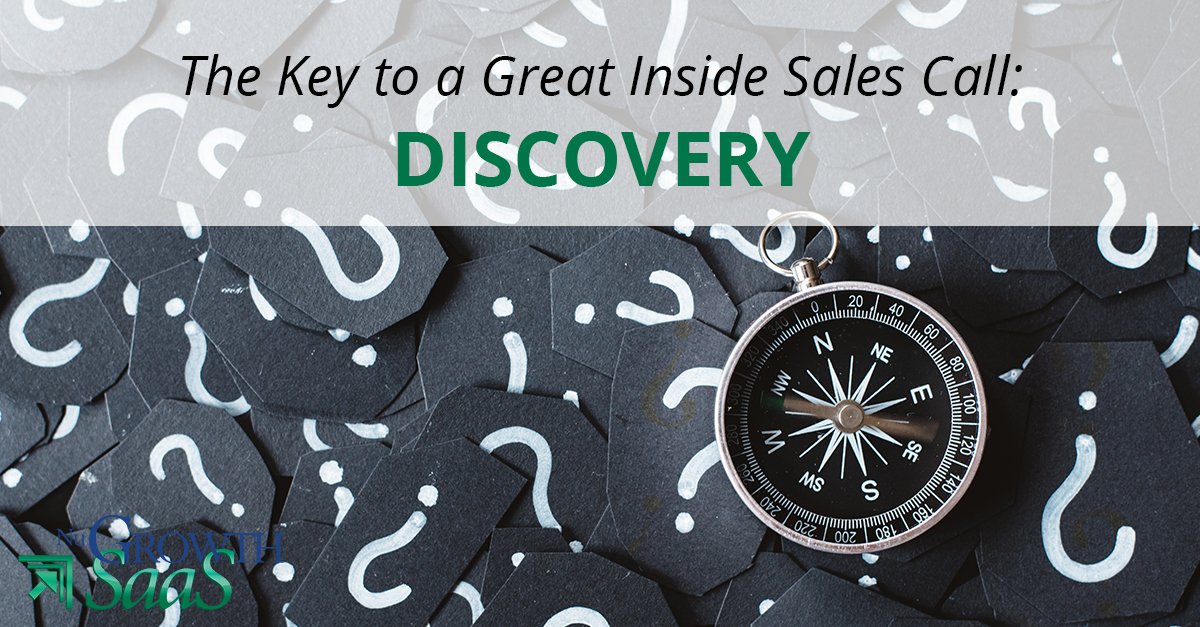Why Discovery Matters
Discovery is one of the most critical skills in any inside sales call. Discovery hits at the core of all sales: uncovering relevant facts and information about the prospect and their needs.
At NuGrowth Solutions we live by many sales principles, including our new business development team focus: listening grants speaking. Listening is a mindset and an important one when trying to master the art of discovery in sales.
As part of NuGrowth Sales as a Service best practices, our business development team members are taught to ask questions in 5 different types of discovery categories. Through these questions, we establish rapport, understand an individual’s personal opinions, and uncover an organization’s motivation for change.
5 Categories for Successful Discovery Questions
When speaking to prospects for the first time, it’s essential to learn as much as you can. If your business development team works only to qualify an opportunity for the sales team, they might be missing out on the “why” by just focusing on the “what.”
Below is a breakdown of 5 core areas your business development team should focus on for authentic discovery.
#1 Personal Discovery
Every business development representative struggles with getting a prospect to “open up” on the first call. That’s why Personal Discovery is the best place to start a positive dialogue.
Questions in this bucket center around asking about the prospect’s opinions. Everyone has an opinion and are eager to share it. So, start here and learn how they feel about their team’s current results, ability to improve, and what’s important to them when working with a new firm.
Other types of questions in this category dig deeper into what you can learn about the individual. Focus on asking things like how long they have been at the company, what got them into that line of work, where they went to school, how long have they been in the area, etc. The more we ask about the person and not just the company the more likely you’ll establish rapport around shared interests. That rapport builds trust, and trust wins sales.
#2 Current State
In this stage, you’re answering the question “what is the status quo?”
Current State is about understanding what systems and processes they currently use. It’s seeing if they outsource and who they partner with, getting a feel for how they’re structured.
You are trying to gauge how they are currently set up rather than who makes the decisions and in what time frame. This phase provides insight into what’s in place, why, and how it’s currently going.
Other relevant questions for this category would be; Are they hitting their goals? What is the plan in place? What initiatives are they focused on?
#3 Operational Discovery
Not every prospect will be a good customer fit, and it’s better for you to find that out sooner rather than later. Ask qualifying questions to see if they match a company profile you target and get into specifics on what they can afford and when. Questions around budget, decision makers, how they buy, fiscal year, etc. all apply here.
This section will flow more naturally after you’ve spent some time on Personal Discovery and Current State. They’ll be more willing to provide the info you need to qualify after you invested time learning about them and what they care about.
#4 Dream State
This is about understanding where they want to go and why. Once you took time to get to know their opinion, how their team is structured, and what their current processes are, you need to understand if there is an appetite for change.
If they are happy with the status quo, there’s not much you can do to influence “the better way.” People don’t want to be sold to, but they love to buy. In order to enjoy the buying experience, it’s important for the prospect to voice what they want and why. That way it becomes real, and you begin to work together on how you can accomplish a Dream State together.
Once they share what they want, all you need to do is advocate why you’re the right partner to bridge the gap between current state and dream state.
#5 Need to Have vs. Nice Have
In this stage, you’re discovering what they’ll buy now. This is the last category of discovery in the sales process and shouldn’t be overlooked when closing a sales call.
Simply asking, “in your opinion what is a need to have vs. a nice to have right now?” will allow you to understand the path of least resistance lock in a deal and establish urgency to the sale.
If the prospect says it, it’s real. If they say they need to have something, then they have committed to change. After that, all you need to do is help them get what they want. Convincing and selling go out the window. By asking this question, you remove the negotiation factor. With this one tactic, you’ll find that your sales cycles will go faster and you’ll close more deals than ever before.
Discovering an Effective Partner
It’s crucial for a business development team to question intelligently, listen attentively, and discover what’s important to a prospect before positioning a product or service. Download our discovery note taking sheet to put our tips into practice. Discover how NuGrowth Solutions Sales as a Service can help your business development team do just that. Give us a call at 800.966.3051 or fill out a contact form here.

Kyle Tillar is VP of Sales for NuGrowth Solutions, working to ensure clients reach their goals and inside sales teams meet objectives. Under Kyle’s leadership, NuGrowth sales teams have generated hundreds of million in pipeline revenue and closed ACV for clients. Leveraging his sales expertise and extensive training, Kyle excels in developing go to market strategies and sales processes to increase KPI’s and results.

